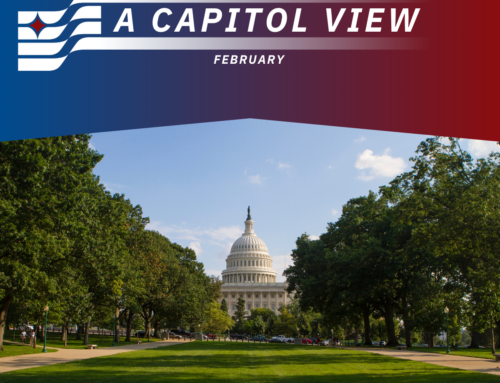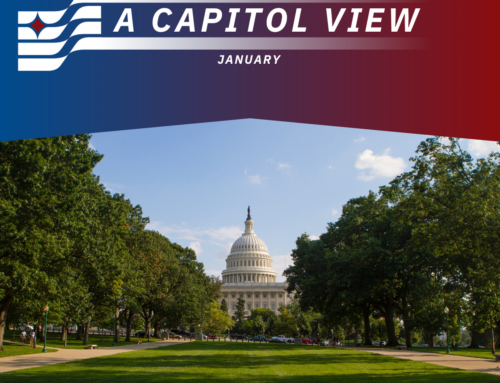Greetings from Washington D.C.:
We hope you and those you care for are doing well and staying safe as we continue to face the public health and economic challenges of the coronavirus pandemic. We trust that better days are ahead with news of multiple vaccine candidates on the near horizon.
First, congratulations to the Joe Biden and Kamala Harris team for their big win in November! The strategic direction of the United States, particularly when it comes to climate change and international partnerships, will now undergo a significant transformation. The U.S. will soon be led by a new President that is more favorable towards renewables in general and hopefully the water power sector in particular. While we worked hard to hold off massive cuts to renewable energy innovation funds proposed over the past four years, we have seen firsthand how Executive Orders and other political maneuvers have disrupted renewable energy research and deployment investments made over the past decade.
Since our last newsletter, Congress has made progress on our legislative goals that may soon lead to increased resources and updated guidance for U.S. Department of Energy (DOE) research programs, including the Water Power Technologies Office (WPTO). We’ll go into more detail on that below.
Much of our current effort is focused on securing increased funding for the WPTO through the regular appropriations process or any upcoming economic stimulus package. Given the economic challenges now facing the nation, we think back to the early days of the Obama/Biden Administration. The U.S. was impacted by a severe recession similar to the current economic conditions of high unemployment and small business disruption.
In early 2009, Congress passed the American Recovery and Reinvestment Act of 2009 (ARRA) – which included the largest single investment in clean energy in U.S. history. The Office of Energy Efficiency and Renewable Energy (EERE) made over $17 billion in grants, including investments in battery manufacturing, combined heat and power, hydrogen and fuel cells, solar, wind, geothermal, low income weatherization and funding to the states for energy efficiency. While SMI was successful in securing ARRA funding for many of its clients, the Obama/Biden Administration made the disappointing decision to not make meaningful investments in water power at the time. Marine energy technologies received only $1 million from that $17 billion.
Unfortunately, that decision has had a lingering negative impact, particularly for the non-commercialized marine energy sector, over the past decade here in the United States.
With the new Biden/Harris Administration planning for a transition to a clean energy economy and new funding for renewables, we need to be organized and have a seat at the table heading into 2021. Earlier this year, we helped develop the National Hydropower Association (NHA) water power stimulus proposal when the CARES Act was considered by Congress. Understandably, Congress shelved infrastructure investments at that time in order to address more near-term and critical COVID-related priorities such as loans and grants for small businesses, unemployment benefits, and direct support for states, municipalities, and educational institutions.
However, our lobbying efforts earlier this year are still relevant today. With low oil prices and high unemployment in the fossil fuel industries, along with a pro-renewables Biden/Harris Administration, there may be increased focus on efforts to help displaced workers shift into the water power industry and other renewables. We need to work hard and prepare to capitalize on upcoming federal investments to boost all forms of water power and secure our place at the table when important decisions are made. It is time to actively pursue Congressional support should an infrastructure package become reality over the next several months.
We need your help to make this happen! If you are not yet a member of the NHA Marine Energy Council, please join! Every member should be reaching out to their elected officials to communicate the importance of water power and how federal investments can support carbon reduction goals, new job growth and clean, affordable electricity.
We will be back in touch soon with updates. In the meantime, please stay in touch, be safe, and we look forward to happier and healthier times!
The SMI Water Power Team
Fiscal Year 2021 Appropriations – Funding for Water Power
The U.S. Federal Government continues to be funded under what is called a Continuing Resolution (CR) for Fiscal Year (FY) 2021 that will expire on December 11. While the House of Representative approved the majority of its FY 2021 appropriations measures earlier this year, the Senate waited until three weeks ago to release funding details. Senate and House staff are now negotiating final funding levels to meet the December 11 deadline. Those decisions could be delayed by a week or so before being finalized by the end of this year.
We are fortunate that the House recommended a DOE WPTO budget of $145.5 million, including $98 million for marine energy and $39 million for hydropower/pumped storage. This is the highest funding level ever approved for water power in a House approved Energy and Water Development appropriations bill. The related report also contains favorable directive language for the WPTO, including for research and development, testing, deployment, and the Powering the Blue Economy initiative. The Appropriations Committee included $40 million for a balanced portfolio of competitive solicitations to support industry- and university-led R&D. It also included up to $10 million to address infrastructure needs at marine energy technology testing sites. The House language for the WPTO is on page 104 of the FY 2021 House Energy and Water Development appropriations report.
Not to be outdone, the Senate announced a funding level of the WPTO at $148 million, including a new record funding level for marine energy at $109 million, along with $39 million for hydropower/pumped storage. The Senate measure includes $60 million for industry- and university-led R&D and the same $10 million to address infrastructure needs at marine energy technology testing sites. It also includes language we lobbied for related to waiving DOE cost share requirements for small businesses. The Senate language details guiding the direction of the WPTO is on page 91 of the FY 2021 Senate Energy and Water Development appropriations report.
In addition, we were pleased to see our lobbying activities were successful when both the House and Senate each provided up to $35 million for Navy alternative energy research. These funds are for prototyping and development of energy systems for future naval capabilities related to at-sea persistent surveillance, communications systems, and unmanned undersea vehicle charging. Specifically, Congress encouraged the Navy to partner with universities, affiliated research facilities, and other federal agencies to conduct research on electrical power intermittency, integrating renewable energy sources into the grid, energy storage, improved micro-grids, local generation of zero-carbon fuels, marine hydrokinetic energy converters for autonomous systems, tactical energy solutions, and the inspection and structural health monitoring of critical energy infrastructure.
As we mentioned above, there are ongoing negotiations between the Senate and House in determining at what levels to fund the government for the remainder of FY 2021 and whether to include any additional economic stimulus measures as part of that package. We are working with congressional staff to ensure maximum funding levels for water power R&D and will report on details of the final agreement and enactment of the spending measure.
In addition, should there be negotiations related to an infrastructure package over the next few months, our focus will be on including provisions in support of the Water Power sector. These include securing significant funding for “shovel/water ready” projects and waiving cost share requirements for universities, small businesses, and non-profits. We will also seek parity with other renewables should there be a special tax credit package.
Regardless, with the change of Administration, we can expect significant progress towards our agenda to increase funding for new marine energy and hydropower technologies.
Green Economic Stimulus
We expect that one of President Biden’s early legislative initiatives will likely include support for clean energy technology development and deployment. With the Senate potentially remaining in Republican control, albeit narrowly, Democrats will have to scale down their climate change related ambitions. However, there are many previously introduced legislative and policy proposals to use as a template for future negotiations, ranging from the 500-plus page report prepared by the House Climate Crisis Committee to recommendations from an informal Senate panel and Biden’s own $2 trillion plan.
President-elect Biden promised to zero out emissions from the power sector by 2035, an aggressive target that will require at least a 7-fold increase in renewable energy, along with rapid construction of transmission lines and expansions of supply chains. Biden also promised to retrofit about 1.5 million buildings per year to improve their energy efficiency, and to push for a massive expansion in the number of electric vehicles. The arrival of a genuine — and green — infrastructure push could create thousands of jobs and inject billions of dollars into the economy. Any legislative package would almost certainly include provisions making investments in electric vehicle infrastructure, extending clean energy tax incentives, and modernizing the nation’s drinking water infrastructure. A model for those could be the House infrastructure bill, H.R. 2, which passed earlier this year and included a massive green energy plan.
New DOE WPTO Legislative Guidance – Reauthorization for Research and Innovation
We are happy to report that HR 6084, the Water Power R&D bill, was included in the omnibus legislation H.R. 4447, the Clean Economy Jobs and Innovation Act. The bill was approved by the House and authorizes just over $900 million for marine energy and $319 million for hydropower/pumped storage R&D over the next five years with a lot of great program direction as well. There is a similar version in the Senate (S. 1821) which is still awaiting floor action. Senate Energy and Natural Resources Committee Chair Lisa Murkowski (R-AK) has stated on several occasions that the bill’s passage remains a top priority for her this year. We are working with our Congressional supporters to include industry preferences in the final version should there be action in the final weeks of this Congressional session. From our conversations with Hill contacts directly involved in the House-Senate negotiations, we believe the Water Power R&D bill is well positioned to be included in a “slimmed-down” final product. However, if the legislation is not considered during the lame duck session, we will need to start over once again in the 117th Congress but will be well positioned for passage of the bill early in 2021.
New Marine Energy Commercialization Action Plan
SMI is leading the effort for the Marine Energy Council in developing a new roadmap for policymakers to support commercialization of the marine energy sector. It is our intention to broadly distribute the MEC plan to Congress, the Biden transition team for DOE and other relevant agencies. A draft of the roadmap can be found here and we welcome any comments on how it can be improved and strengthened.
Recent DOE WPTO Funding Opportunities
The U.S. Department of Energy (DOE) recently announced the Small Business Innovation Research (SBIR) and Small Business Technology Transfer (STTR) Phase I, Release 2 topics, which include several WPTO-related topics/sub-topics and can be found here.
TEAMER
The Testing Expertise and Access for Marine Energy Research Program has opened its second Request for Technical Support (RFTS2), which is accepting applications through December 18, 2020. If you miss this round, have no fear. The third RFTS is expected to open for applications in the March 2021 – April 2021 timeframe for testing from August 2021 through February 2022. The TEAMER program was established to provide access to testing infrastructure, world-class expertise, and consistent testing protocols.
ARPA-E SHARKS Awards Announced
The DOE Advanced Research Projects Agency-Energy (ARPA-E) recently awarded $35 million for the development of turbine designs for tidal and riverine currents. The funding is being awarded under the Submarine Hydrokinetic and Riverine Kilo-megawatt Systems (SHARKS) program to eleven projects, which will address at least one of four generation use-cases: remote riverine energy, remote tidal energy, utility-scale riverine energy, and utility-scale tidal energy. Projects will work towards significantly decreasing the cost of energy of the turbines through multiple approaches, including increasing generation efficiency and rotor area per unit of equivalent mass, lowering operation and maintenance costs, minimizing potential impacts of surrounding environments, and maximizing system reliability. Congratulations to the winning teams! Click here to learn more.
2021 International Conference on Ocean Energy (ICOE) Goes Virtual
The National Hydropower Association (NHA), host for ICOE 2021, recently announced that the conference will be held utilizing a virtual format. The event is scheduled for April 28-31. NHA is working to bring attendees a unique virtual experience, focused around content and networking opportunities. The conference will showcase breakthroughs in ocean energy technology research and development, demonstrate how ocean renewable energy benefits the larger “Blue Economy” and the electrical grid, and identify research areas needed to further advance the state of the technology. Please join us! Updates on the conference will be posted to the event website at https://icoe2021.org.
WPTO Job Opening – Marine Energy Technology Manager
Are you interested in working in the Water Power Technologies Office (WPTO)? The office is looking for a new member to join the team as a General Engineer with the WPTO’s Marine Energy Program. As a Technology Manager and Technical Project Officer, the position will manage research, development, and demonstration activities related to marine energy technologies. The candidate must have expertise in marine energy, experience in project management, and oral and written communication skills. Please see WPTO’s announcement for details about the position and instructions on how to apply.
Environmental Permitting and Compliance Cost Reduction Strategies: Lessons Learned from Other Industries
In June, an important paper was released in the Journal of Marine Science and Engineering on addressing the challenges to advancing an economically competitive U.S. marine energy industry. The paper provides an in-depth review of environmental permitting pathways, the main environmental concerns and types of monitoring typically associated with them, and factors that appear to have eased environmental permitting and compliance issues.
New Vision Report from Ocean Energy Europe
The 2030 Vision for Ocean Energy was released a few weeks ago and is an excellent plan for achieving massive, utility-scale, deployment of ocean energy systems. We are excited to see our colleagues in Europe take the initiative in laying out a grand vision for marine energy!
European Union Sets New Targets for Marine Energy Deployments
Building on the great work by Ocean Energy Europe, the European Union announced this fall new targets for marine energy deployment over the next decade and beyond. The European Strategy for Offshore Renewables will provide an important boost to marine energy technologies. The strategy is committed to support a pipeline of 100MW of marine energy projects in the water by 2025, and at least 1GW by 2030. A 2050 deployment target of 40GW provides an impressive goal for building out the sector over the longer term. Once again, the Europeans are taking the lead on marine energy commercialization efforts!
Congratulations to Verdant Power and ORPC
We are pleased to share that the U.S. now has two operational riverine and tidal energy systems deployed and providing power to New York City and Igiugig, Alaska. Verdant Power CEO John Banigan gives an update on the East River deployment in this four-minute video. We also think this news story does a great job summarizing the Verdant RITE project and laying out both the promise of, and challenges facing, marine energy commercialization. Also, check out this four-minute video on the ORPC Igiugig project. We congratulate both Verdant Power and ORPC for their excellent work and we look forward to seeing more deployments next year.
PNNL State of the Science Report
PNNL recently released the final 2020 State of the Science Report on behalf of the DOE WPTO and the International Energy Agency’s Ocean Energy Systems technology collaborative. The authors reported that, with the few marine energy devices deployed to date, no marine mammals, fish, or seabirds have ever been observed colliding with a device. There’s also no evidence of harm from underwater noise from operational devices or electromagnetic fields emitted from electric cables; no significant changes in habitat have been caused by marine energy devices; and potential changes to oceanographic systems or entanglement of marine animals with mooring systems or cables pose very low risks. We applaud PNNL’s research which further reinforces the business case for widespread deployment of marine energy systems.
The Marine Energy Opportunity
Marine energy represents the next generation of renewable power technologies. Marine energy (produced by waves, tides or currents) has tremendous potential to provide significant amounts of clean, renewable electricity while creating high-value employment opportunities. In addition, marine energy is reliable, predictable and environmentally friendly. The resource is close to population centers and can provide power to many different maritime markets and emerging Blue Economy opportunities. Finally, marine energy can help to revitalize our nation’s ports and shipyards as devices can be built and maintained near generation sites.
We encourage the incoming Biden Administration to review the European Commission report on wave and tidal energy which has forecast global installed capacity to hit up to 3.9 GW by 2030 based on current levels of political support. The International Energy Agency Ocean Energy Systems 2050 Vision predicts 300 GW of global marine energy installed capacity, with $35 billion in investment and 680,000 direct jobs.
Recent news on marine energy projects from around the world can be found at RENews – Wave and Tidal or the IEA-Ocean Energy Systems Country Reports. You can also find updates on the PNNL Tethys or the DOE Water Power News sites.




